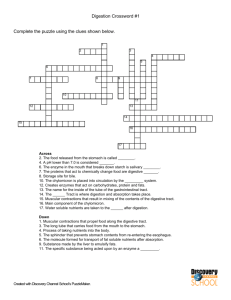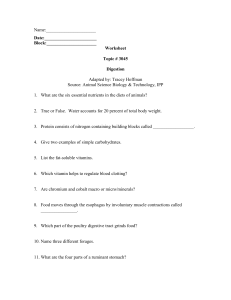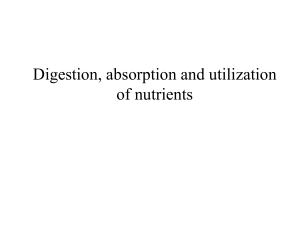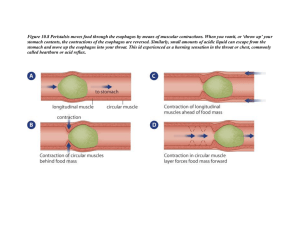Guided Tour through the Ruminant Gastrointestinal Tract Mouth -
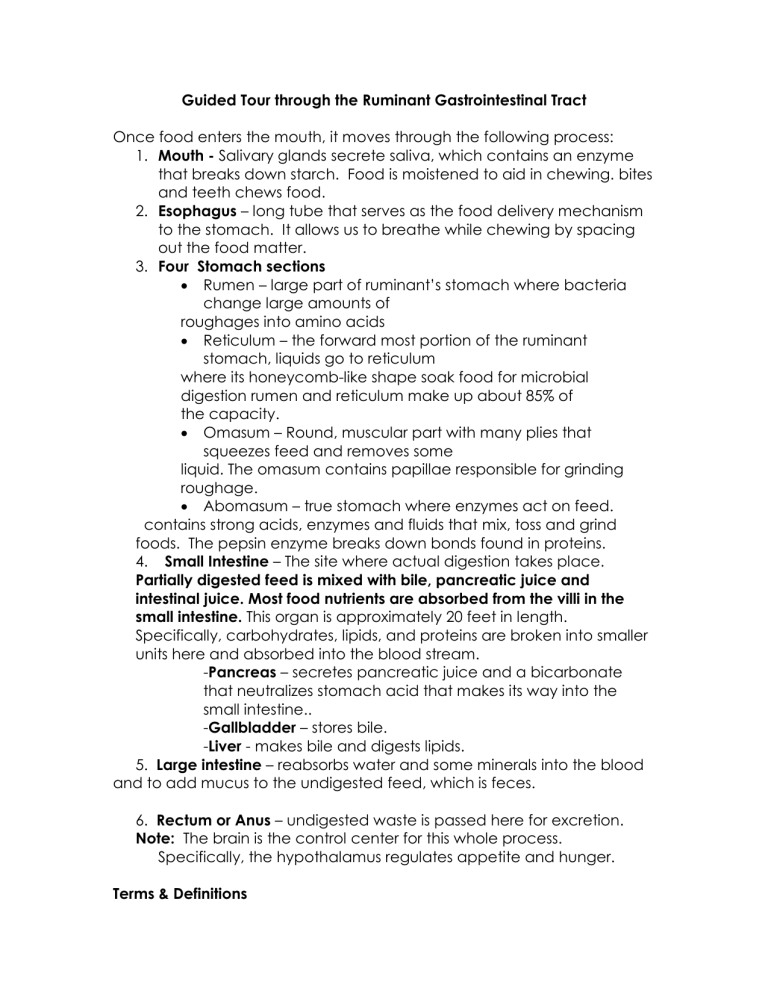
Guided Tour through the Ruminant Gastrointestinal Tract
Once food enters the mouth, it moves through the following process:
1.
Mouth - Salivary glands secrete saliva, which contains an enzyme that breaks down starch. Food is moistened to aid in chewing. bites and teeth chews food.
2.
Esophagus – long tube that serves as the food delivery mechanism to the stomach. It allows us to breathe while chewing by spacing out the food matter.
3.
Four Stomach sections
Rumen – large part of ruminant’s stomach where bacteria change large amounts of roughages into amino acids
Reticulum – the forward most portion of the ruminant stomach, liquids go to reticulum where its honeycomb-like shape soak food for microbial digestion rumen and reticulum make up about 85% of the capacity.
Omasum – Round, muscular part with many plies that squeezes feed and removes some liquid. The omasum contains papillae responsible for grinding roughage.
Abomasum – true stomach where enzymes act on feed.
contains strong acids, enzymes and fluids that mix, toss and grind foods. The pepsin enzyme breaks down bonds found in proteins.
4. Small Intestine – The site where actual digestion takes place.
Partially digested feed is mixed with bile, pancreatic juice and intestinal juice. Most food nutrients are absorbed from the villi in the
small intestine. This organ is approximately 20 feet in length.
Specifically, carbohydrates, lipids, and proteins are broken into smaller units here and absorbed into the blood stream.
-Pancreas – secretes pancreatic juice and a bicarbonate that neutralizes stomach acid that makes its way into the small intestine..
-Gallbladder – stores bile.
-Liver - makes bile and digests lipids.
5. Large intestine – reabsorbs water and some minerals into the blood and to add mucus to the undigested feed, which is feces.
6. Rectum or Anus – undigested waste is passed here for excretion.
Note: The brain is the control center for this whole process.
Specifically, the hypothalamus regulates appetite and hunger.
Terms & Definitions
Ingestion – eating and swallowing food and liquids.
Digestion – the breakdown of food into its individual nutrients.
Absorption – nutrients in contact with the cell wall of the GI tract for an extended period of time are passed into the cells.
Transportation – nutrients are transported in the blood to the liver where they are processed and sent to parts of the body to use.
Peristalsis – layers of muscles squeeze and push food along the
GI tract.
Mastication (chewing) – increases the surface area of the food and mixes saliva enzymes and water with the food
Fun Facts about Digestion
When food goes through the process from ingestion to excretion about 24-72 hours have lapsed. If a person’s diet is high in fiber, that time is reduced.
Why doesn’t the stomach digest itself? A substance called gastric mucus is made inside the body. This substance lines the stomach wall so that acids can’t eat away at the stomach lining.
The liver is an important organ in the body. Not only does it
“process” nutrients to send to other parts of the body, but it also detoxifies harmful substances that are ingested into the body.
Putting too many harmful substances into the body can cause cirrhosis, or hardening of the liver.
The process of peristalsis slows down as humans age, thus increasing the risk for constipation.
Your assignment:
Create a brochure or small booklet that will serve as a “travel guide” of the gastrointestinal tract.
Your guide should include the following components: o o A hand-drawn or computer generated picture of all seven “locations” in the digestive tract & the stomach with the 4 “sites” or sections. o o A physical description of each location. o o A creative explanation of interesting features, tour options, etc., that can be visited at each stop.
The emphasis on this assignment will be placed on creativity.
The goal is that you understand each part of the digestive tract well enough to create analogies between it and a real-life location that is known for tourism.
